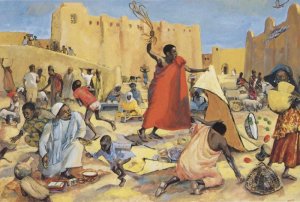Almighty God, you know that we have no power in ourselves to help ourselves: Keep us both outwardly in our bodies and inwardly in our souls, that we may be defended from all adversities which may happen to the body, and from all evil thoughts which may assault and hurt the soul; through Jesus Christ our Lord, who lives and reigns with you and the Holy Spirit, one God, for ever and ever. Amen. (Collect for the Third Sunday in Lent, Episcopal Book of Common Prayer)

It’s always a bit jarring to me when the RCL moves from following one of the synoptic gospels (this year, of course, it’s Mark) to a reading from the Gospel according to John. This Sunday is one of those days; our gospel comprises John’s version of the story of Jesus cleansing the Temple. In John’s chronology, this event takes place just after Jesus’ first sign, turning water into wine in Cana, rather than during the latter days of his ministry as it does in the synoptics. Placing the story here is part of John’s larger strategy of showing how Jesus both challenged the authorities and revealed his identity and authority with signs from the first days of his ministry.
What fascinates me about this gospel is that the merchants and money changers in the Temple were actually necessary for Temple sacrifice and worship to take place. Pilgrims traveling long distances to celebrate Passover in Jerusalem couldn’t always bring the required sacrificial animals along; ordinary coins imprinted with images of Caesar couldn’t be used to pay Temple taxes. Matthew, Mark, and Luke situate this story in a way that makes it easy to think that perhaps Jesus is reacting to corruption on the part of the money changers and merchants, but John gives us scant reason to think this. Instead Jesus’ actions seem to come from a zeal for upsetting the status quo.
One way to think about this is to consider that Jesus came to replace the Temple because the Temple and the practices that took place there had become not a conduit to God but rather a barrier to truly knowing God and doing God’s will in the world – not an entirely new idea, but one that the prophets, notably Isaiah, Amos, and Micah had earlier raised. As David Lose pointed out three years ago, all of this might lead us to the very real question of whether our churches have done exactly the same thing: do we risk constraining God, keeping God boxed up in the very houses we construct to honor God’s glory, and in which we come to worship? Do we love our buildings and our liturgies more than we love God?
Another possible theme for Lent can be found in our reading from Hebrew scripture. Following on the stories of Noah and

Abraham, we hear this week about Moses receiving the Ten Commandments. As we prepare for the events of Holy Week, for the institution of the New Covenant, I’ve been exploring the covenants God has entered into with the people of Israel. What do these covenants – the promise to Noah and his descendants never to destroy creation again, the promise to Abraham that he will be the father of a people as numerous as the stars, and that El Shaddai will be their God and they will be God’s people, and finally, the set of laws to regulate ethical behavior and worship received as the Ten Commandments – have to do with our lives today? How do these promises find their expression in Jesus, and through Jesus, in our ethical thought, our worship, and our behavior? What does it mean for God to promise to be in relationship with us? LOTS to think about for Lent. Since I don’t often preach on OT texts, I am enjoying new avenues to explore.
How about you, preachers? Do you have a Lenten series going on? Are inspired by this week’s readings, or befuddled? If you live where it’s winter, are you holding up through the ice and snow (getting really OLD in my part of the world!) Join the conversation; we’re here for each other!


The image of temple became personal for me in my prayer writing. Here’s a sample:
It’s hard to identify exactly when they moved in – the voices making promises, selling their fixes, displaying their idols. Echoing inside our head, the temple has become a noisy marketplace.
Lord have mercy.
Lord have mercy.
It’s foolishness! There’s nothing to quell our desire, no law to bring peace to our troubled souls. But the One who was sent knows human nature well.
Christ have mercy.
Christ have mercy.
Cleanse, purge, drive out all that bullies you. Let zeal for your house consume you.
Lord have mercy.
Lord have mercy.
More prayers can be found here.
LikeLike
Thanks for this! I’m stuck on covenant these days. I’ve kind of re-written the Ten Commandments this week. Here’s what I have although I’m not sure how it will fit with my sermon just yet. https://rachaelkeefe.wordpress.com/2015/03/05/10-commandments-2-0/
LikeLike